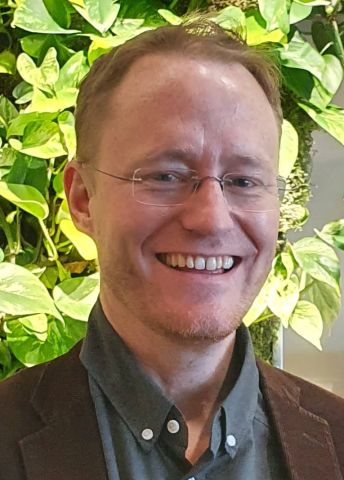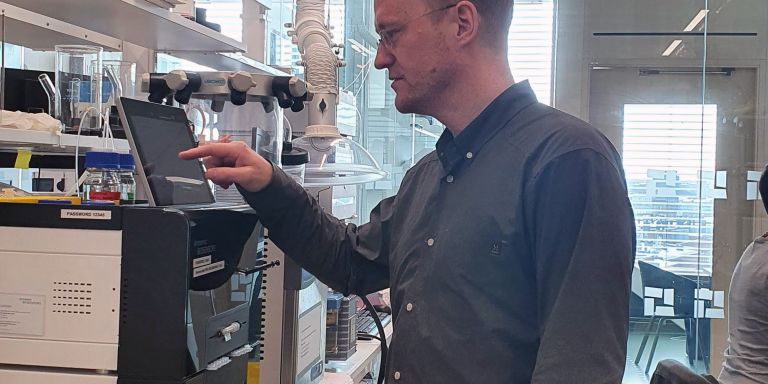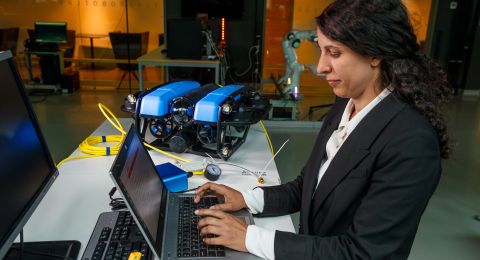Björn Högberg is developing molecular tools for biological research, often based on DNA origami – a method of folding DNA into precise, nanoscale structures. He uses them to study how cells communicate, in the development of vaccines, and as drug-delivering nanobots.
Björn Högberg
Professor of Molecular Systems Biophysics
Wallenberg Academy Fellow, prolongation grant 2017
Institution:
Karolinska Institutet
Research field:
DNA origami and other molecular biological technologies used in biological research
Origami is the art of folding paper into three-dimensional objects. A crane (the bird) is a well-known example.
But in Högberg’s lab at Karolinska Institutet’s Biomedicum research center, it is DNA strands rather than paper that are being given new shapes using a technique called DNA origami.
“DNA origami enables us to build nanoscale structures simply and with high precision. Many cell mechanisms in our bodies take place at this scale, and we can use DNA origami to study them in new ways,” says Högberg, who is a professor of molecular systems biophysics.
His research team often uses their DNA origami as a base on which they can place other molecules with great precision. Among other things, this has enabled them to study antibodies – Y-shaped proteins belonging to the immune system.
The researchers placed the proteins to which antibodies bind, known as antigens, different distances apart on plates of DNA. They then determined how the distance affected antibody binding. A distance of 16 nanometers was found to be optimal.
Högberg made this discovery during his first period as a Wallenberg Academy Fellow. Thanks to an extended grant, he and a fellow researcher who is working on HIV are now continuing their work in this field.
“We intend to give animals DNA origami structures in which we control the distance between the antigens very precisely indeed. We want to see what effect this has on activation of the immune system, and the implications of this for design of a vaccine for HIV.”
Protein patterns impacting cell death
The team is also using DNA origami to study how receptor molecules on the cell surface react to various protein patterns. This is of interest because so because many mechanisms in the body, such as communication between cells, require a cell to display proteins on its surface that another cell recognizes via its receptors. The importance has been found to lie not only in the fact that a cell displays the proteins on its surface, but also in how they are placed on the surface.
One research topic is a receptor that binds to a certain protein, thereby causing the cell to commit suicide. The research team has shown that if they add the protein freely in the fluid in which cells live, the cells continue to live as normal. Nor does anything untoward happen if they place the protein in a dispersed pattern on a DNA origami and add cells.
“But if we place them in a small group – more than three, 5–10 nanometers apart – and add cells, the suicide process becomes highly effective. When we know more about how this works, it may be possible to create a drug based on displaying this pattern to cells we want to commit suicide.”
Nanobot delivering drugs
The team is also developing a type of nanobot capable of delivering drugs to specific cells. It is based on a DNA origami structure shaped like a barrel, with drug molecules on the inside. Using special short DNA strands, called aptamers, it is possible to get the barrel not to open until it comes into contact with specific cancer cells.
Högberg considers the results to be promising at cell level, and says that the team will now begin studies on animals. But it is not certain that the research will lead to a drug that actually contains DNA origami structures.
“We’re trying things out at nanoscale. We may, for instance, conclude that a given drug works better if you place a certain number of proteins at a certain distance from each other. But the end product need not necessarily contain DNA origami, even though the knowledge that made it possible comes from there.”
But not all methods developed in Högberg’s lab are based on DNA origami. During the corona pandemic the team has been working to improve methods of detecting the virus, in collaboration with Björn Reinius, who is a laboratory neighbor.
New ways of revealing active genes
Högberg is also working on a new method of creating a picture of gene expression – which genes are activated and form mRNA – in a cell or tissue sample. The idea is that the method should not only be able to say which genes are expressed by individual cells; it should also show where in the tissue the specific cells are located.
Simply put, the researchers achieve this by linking random snippets of DNA to all mRNA molecules in a sample. They then add the enzymes that induce the DNA sequences to join up. The newly formed DNA molecules are detected, revealing which snippets of DNA have ended up next to each other. Then, with the help of a computer, the researchers can piece together a puzzle showing how all DNA sequences must fit together.
“We want it to be a simple laboratory procedure to take a tissue sample, carry out some enzymatic reactions and immediately obtain loads of data on how all the genes fit together in the tissue. In theory it will work, but first there are lots of technical problems to be solved.”
“This grant means an awful lot to us. It means we can commit to riskier projects, which are often the ones that are most interesting. We can afford to get to the bottom of difficult questions, and not just address simple ones so we have something to show for our research.”
But Högberg has nothing against solving problems – on the contrary.
“I like the feeling of sitting down and pondering how to solve a problem. It’s one of the best things about research.”
Text Sara Nilsson
Translation Maxwell Arding
Photo Yunshi Yang, Ferenc Fördös






